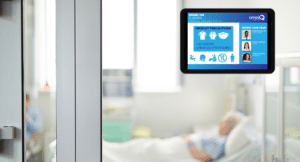From Chaos to Order: How omniQs Electronic Signage Transformed Patient Care in a Hospital, Delivering a Happily Ever After for Patients and Healthcare Providers Alike
Once upon a time, patient care in hospitals was a complex process that involved multiple steps and human interactions. From registration to discharge, patients encountered a range of healthcare professionals, all of whom played a critical role in their care. However, even with the best intentions, the process was often marred by confusion, miscommunication, and delays.
But then, something changed. One hospital decided to implement a new system that promised to streamline the patient care process and enhance the overall experience for both patients and healthcare providers. That system was omniQs electronic signage, a cutting-edge solution that used digital displays to provide real-time information about patients and their care plans.
At first, some healthcare professionals were skeptical. After all, they had been working in hospitals for years and were accustomed to the existing processes. However, as they began to see the benefits of the new system, their attitudes quickly changed.
One of the most significant benefits of omniQs electronic signage was the ability to provide real-time information about patients. Previously, healthcare providers had to rely on paper records or verbal communication to stay up-to-date on their patients’ conditions. However, with the new system, they could access patient information at any time, from anywhere in the hospital.
This led to more efficient and effective patient care. For example, if a patient’s condition changed, healthcare providers could quickly update the digital display to reflect the new information. This meant that other healthcare providers who were working with the patient would be immediately notified of the change, allowing them to adjust their care plans accordingly.
Another benefit of omniQs electronic signage was that it reduced the need for human communication. In hospitals, miscommunication can have serious consequences, such as delayed treatment or even medical errors. However, with the new system, healthcare providers could rely on digital displays to communicate important information to each other. This reduced the risk of miscommunication and allowed healthcare providers to focus on providing care to their patients.
The hospital also saw a significant improvement in patient satisfaction after implementing omniQs electronic signage. Patients and their families appreciated the transparency and real-time updates provided by the digital displays. They no longer had to rely on healthcare providers to keep them informed about their care plans, which gave them a sense of control over their healthcare experience.
Overall, the implementation of omniQs electronic signage had a profound impact on patient care in the hospital. It streamlined the care process, reduced the risk of miscommunication, and improved patient satisfaction. Healthcare providers were able to provide more efficient and effective care, and patients felt more informed and in control of their healthcare experience.
In conclusion, hospitals can greatly benefit from the implementation of cutting-edge technologies like omniQs electronic signage. By providing real-time information and reducing the need for human communication, these systems can enhance patient care and improve the overall healthcare experience for both patients and healthcare providers.

